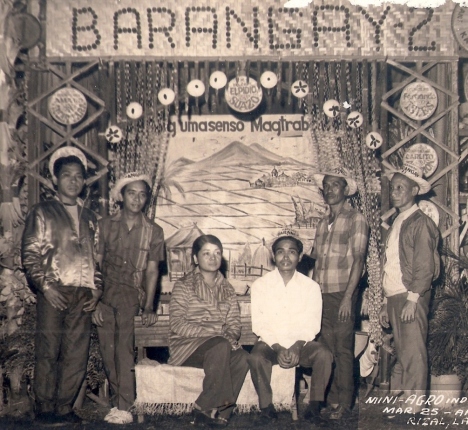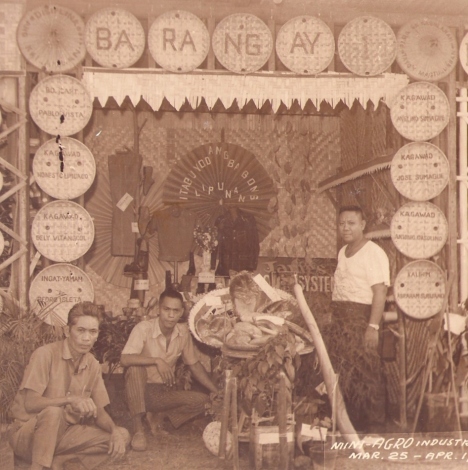Barangay Poblacion. One of the sections of the town of Rizal, Laguna which is the town proper is known as Poblacion.
Formerly, when it was still the prosperous barrio of Nagcarlan, it was known as Pauli because of its river that flows westward and returns eastward. In other words the river goes back and forth which means “Pauli-uli”, in Tagalog. This words was shortened into “Pauli” which was the town given to the barrio.
In the year 1915 up to the later part of 1918, the councilor of that barrio, Mr. Fortunato Arban had been working a secret plan organizing the new town of Pauli. Eight other barrios planned to separate from the municipality of Nagcarlan to be combined with Pauli to form a new town. These barrios were North Pauli, Tuy, Laguan, Entablado, Tala, Talaga and Antipolo.
Not long afterwards, Don Juan Cailles, the Provincial Governor at that time, came to know of the plan. He lost no time in summoning Mr. Fortunato Arban to the Provincial Capitol to talk over the matter. He readily acceded with Mr. Arban and the proposal of the creation of the new town was brought to Manila and prevented to the Philippine Congress. It was indorsed to Governor Francis Burton Harrison who approved it with Mr. Fortunato Arban as the President and Mr. Agustin Vista the Vice President. The appointed councilors were Messrs. Juan Isles, Inocente Sumague, Gregorio Isles, Ceriaco Zuasola, Felix Isles, Claro Munda, Pedro Urrea and Wenceslao Isles.
In 1919, the first local election was held, Mr. Fortunato Arban was elected President and Mr. Agustin Vista the Vice President. The elected councilors were Messrs. Luis Reolada, Pedro Urrea, Norberto Vista, Juan Isles, Inocente Sumague and Felix Isleta.
At that time there was no layout of streets so that the President made it a point to construct streets. He asked the help and cooperation of the people who in turn offered their services free. A public market was built at the expense of the municipality.
Still having in mind the education of the masses as a step towards progress, a primary school was established. The house of Mrs. Potenciana Solis de Arguel was rented to accommodate the school children. Later the Vice-President’s home was also used as the enrollment increased. Then the municipal government sought for a school site wherein to build the Primary Building. In 1920 a site for the Home Economics Building was purchased from the couple Ignacio Isles and Natalia Rubiato. The first intermediate class was opened the same year.
The next election held in 1922. The following officials were elected: Mr. Agustin Vista – President, Mr. Pedro Isleta – Vice President and the councilors were Messrs. Fortunato Arban, Pedro Urrea, Narciso Asegurado, Pedro Sombilla, Leoncio Sombilla, Wenceslao Isles, Claro Munda and Juan Lucido. During this period, the construction of the Primary School Building which was begun in previous administration was completed. A Home Economics Building was also constructed. Another accomplishment was the installation of the waterworks system but this was not finished. The tenure of office end in 1925.
Another President was elected in the person of Mr. Cornelio Viriña in 1925. The Vice-President was Mr. Juan Lucido and under their term, the water works project was completed.
At the expiration of Mr. Viriña’s term, Mr. Fortunato Arban was again elected in 1928 as president. Once more he proved himself to be an advocate of uplifting his people through educating them so there had been a rapid increase in the school enrollment. Another school building was needed so that he made personal appeals to the people to pay taxes in order to have new building erected. His appeal was too much for the people to discard so they had to cooperate with him. Thus, another building was built. It was the present intermediate building.
After his term Mr. Clemente Sombilla took over in the next election in 1931. Not much could be mentioned here. He was succeeded again by Mr. Fortunato Arban in 1934 up to 1937.
With the change in the form of government to a Commonwealth in 1937, Mr. Agustin Vista was once more elected President. His object this time was the improvement of the roads. He succeeded in securing the Provincial Officials help in having the Provincial Road running through the town asphalted.
An excitement was to be witnessed in the 1941 election. It was during this time when the world war was in critical situation due to a threatening war. The candidate running for presidency during this period was a Sakdalista in the person of Mr. Godofredo Asegurado and a Nationalista in a person of Mr. Pablo Urrea.
Mr. Pablo Urrea came out the victor with Mr. Ismael Sombilla as the Vice President. A few months later, World War II broke out. The Japanese came and took command over us. Inspite of the constant grilling by the Nippons, Mr. Urrea stood past in his post bravely tackling the dangerous task of shielding the underground resistance movement in its action which was raging in town. After two years he shifted his responsibilities to the Vice Mayor Mr. Ismael Sombilla.
Mr. Ismael Sombilla was another man who deceived and fooled, the Japanese for the same cause. He helps support the guerillas by giving them food, clothing and information.
About the middle part of the occupation period, the responsibility was transferred to a councilor then Mr. Dionisio Limcuando. The condition during this time was so critical that the inhabitants of Poblacion had vacated their places. Most of them went to the mountain. A truckful of Japanese soldiers was ambushed in the barrio Pook so that in their return trip the town was burned, leaving most of the Poblacion folks homeless. This happened on January 23, 1945. Some houses together with the school buildings, the church and the municipal building were the only ones luckily spared.
Then the town was soon liberated and from the ruins of the houses sprang the so-called “barong-barong”. Former activities were resumed. Schools were opened and the governmental machinery began to function again. The former officials resumed their offices. During this short period, the front part of the
Municipal Bulding was paved on a plaza was constructed and named after the beloved Congressman of the second district of Laguna, Honorable Estanislao A. Fernandez, Jr.
The first local election after the liberation was held on April 23, 1946. There was no rivalry witnessed in this election for the mayor was unanimously elected to office due to his winsome and magnetic personality and bravery which won for him the full support and admiration of the people.
He was inexperienced in the politics but he showed great abilities in tackling the major problems of his administration. He has accomplished so many things as the reconstruction of the old wooden municipality to a semi-concrete building and the replenishing of the plaza which is now worthy pride of the community. But more than all of these is his fearless to right and wrong, his devotion to duty to the sacrifice of his family and his honesty which instill in the people complete thrust that no harm can come to them as long as he is with them.
Another public building that is to be found in Poblacion is the Roman Catholic Church which was set up with the coming of Spaniards. It was at first a make shift with cogon roofing, sawali and bamboo walls and filed floors.
Filed under: Barangay History |
























































Leave a comment